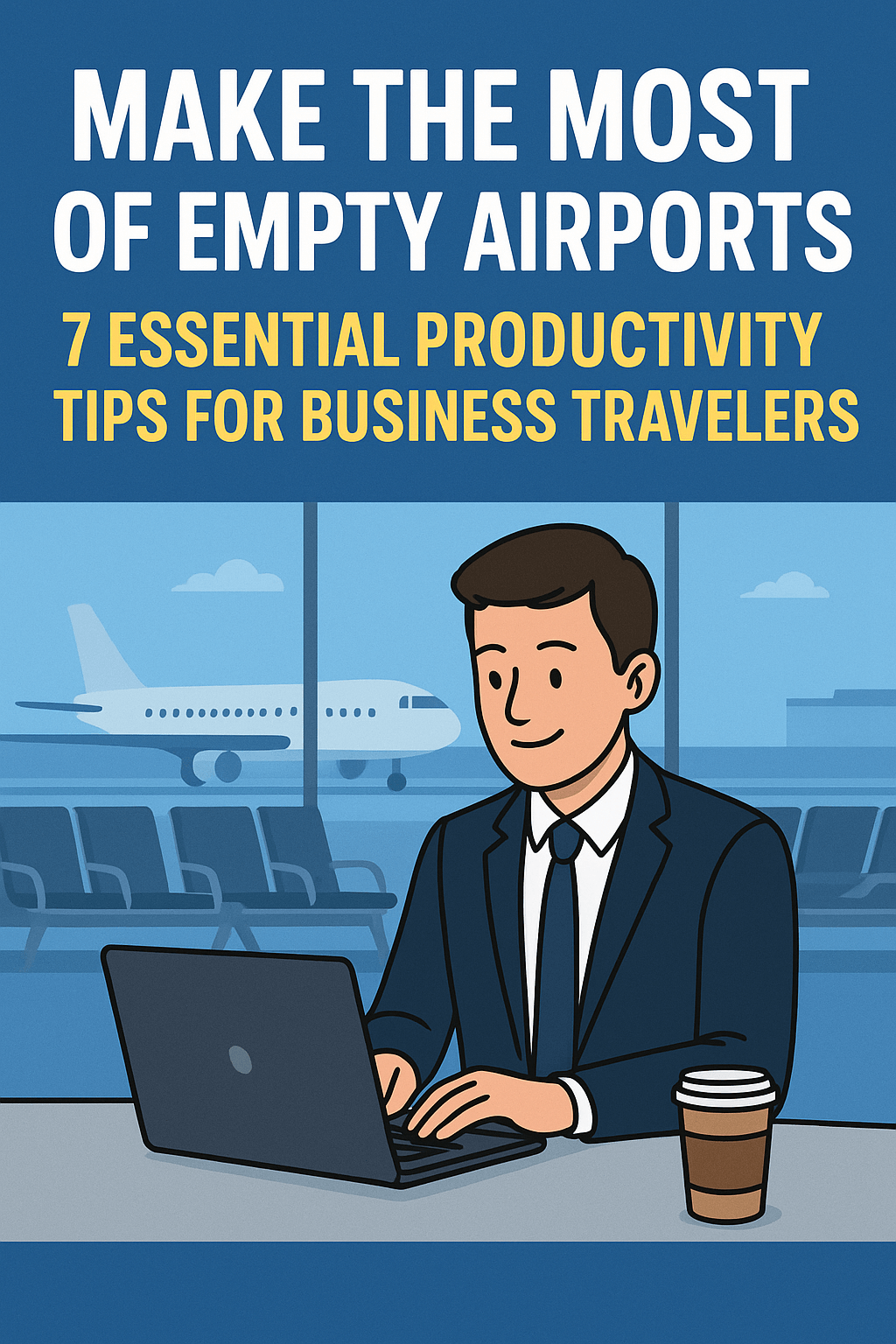Next time you’re stuck in an airport, don’t just scroll through social media or stare blankly at gate displays. Those empty hours between flights can become your most productive time—if you know how to use them right.
As someone who’s logged thousands of miles in the air and countless hours in terminals worldwide, I’ve learned that airports can be surprising productivity hubs. Here’s how to transform dead time into your secret business advantage.
Why Airports Are Productivity Goldmines
There’s something unique about airports that makes them ideal for deep work. You’re in a strange limbo—physically present yet disconnected from your normal environment. You can’t easily be pulled into meetings or handle office emergencies. This isolation creates a perfect bubble for focusing on important tasks.
Research shows that environmental changes can boost creativity and focus. The ambient noise of an airport terminal—not too quiet, not too loud—can actually enhance creative thinking, according to a 2012 study in the Journal of Consumer Research. It’s why many people work effectively in coffee shops.
Plus, the constraints of your departure time create a natural deadline, triggering what psychologists call “productive urgency”—the heightened focus that comes when we have limited time to complete a task.
7 Ways to Maximize Airport Productivity
1. Plan Your Airport Work Session
Before you even leave home, identify specific tasks for your airport time. Choose work that matches the environment—complex writing for quiet lounges, email catch-up for busier gates. Downloading necessary files and resources beforehand ensures you won’t waste precious minutes searching for information.
Consider creating an “Airport Work” folder on your desktop with all the documents, research, and tools you might need. Even if the Wi-Fi fails, you’ll be prepared to work offline.
2. Leverage Airport Lounges
Airport lounges aren’t just about free snacks and comfortable chairs. They’re productivity sanctuaries with reliable Wi-Fi, power outlets, and significantly less noise than the main terminal. Many offer private work areas or even meeting rooms you can reserve.
If you don’t have lounge access through your airline status or credit card, consider purchasing a day pass (typically $40-60). For longer layovers, this investment pays dividends in productivity. Some third-party programs like Priority Pass offer access to hundreds of lounges worldwide for an annual fee.
3. Find Your Ideal Workspace
Not all airport seating is created equal. Scout out these productivity-friendly spots:
- Empty gates for quiet space (check departure boards for gates not in use for several hours)
- Airport restaurants during off-peak hours
- Business centers or designated work areas
- Meditation/yoga rooms (many major airports now offer these)
The ideal spot has three essentials: power outlets, minimal foot traffic, and comfortable seating. Some newer airports even feature work pods or mini-offices you can rent by the hour.
4. Master Your Tech Setup
Your digital toolkit makes or breaks airport productivity. Essential components include:
- Noise-canceling headphones (absolute must-have)
- Portable battery pack for extended work sessions
- Compact laptop stand to improve ergonomics
- Mobile hotspot as backup for unreliable airport Wi-Fi
- Privacy screen to protect sensitive information
Download important files before arriving at the airport, and set up offline access for key applications like Google Docs or Notion. Consider using focus apps like Forest or Freedom to block distracting websites during your work session.
5. Implement Time-Blocking Techniques
Airport time feels different—it’s easy to lose track of hours or waste them entirely. Use the Pomodoro Technique (25 minutes of focused work followed by 5-minute breaks) to maintain concentration without burning out. Set clear alarms for both work periods and, critically, when you need to head to your gate.
I recommend working in 45-minute blocks at airports, using boarding times as natural boundaries. Always build in a 30-minute buffer before boarding starts—nothing kills productivity like the stress of potentially missing your flight.
6. Prioritize Deep Work Tasks
Airports are ideal for tasks requiring sustained attention. Consider focusing on:
- Strategic planning and big-picture thinking
- Content creation (articles, presentations, proposals)
- Financial analysis or forecasting
- Learning new skills through online courses
- Reading industry reports or books
These high-value activities often get squeezed out of normal workdays but thrive in the unique airport environment. Save routine tasks like inbox management for your flight, when you might have less table space or power access.
7. Prepare for Connectivity Issues
Even the best airports have Wi-Fi dead zones or overcrowded networks. Build redundancy into your connectivity plan with:
- Downloaded documents for offline editing
- Pre-written email drafts you can send when connection returns
- Mobile hotspot capability on your phone
- Tasks that don’t require internet access
When Wi-Fi is truly unavailable, pivot to brainstorming, planning, or reading—activities that might actually benefit from being offline.
What Not to Do in Airports
Avoiding common pitfalls is just as important as implementing productive strategies. Don’t make these mistakes:
- Relying solely on airport Wi-Fi without any backup plan
- Starting huge projects that require more time than your layover allows
- Working on highly confidential materials in crowded areas
- Forgetting to charge devices before arriving at the airport
- Waiting until the last minute to find a power outlet (they become scarce during busy periods)
The biggest mistake? Not planning for airport work at all. Without a clear intention, those valuable hours dissolve into social media scrolling or overpriced terminal food.
Creating Airport Routines That Work
The most productive business travelers develop consistent airport routines. Consider this sample itinerary for a 3-hour layover:
60 minutes: Deep focus work in a quiet area (strategic planning or content creation)
30 minutes: Light meal while catching up on industry news
45 minutes: Email processing and team communication
30 minutes: Buffer time for boarding (use for light reading or podcast listening)
15 minutes: Mindfulness practice or short walk to refresh before the flight
Having a template like this reduces decision fatigue and ensures you make the most of every minute. Personalize your routine based on your energy levels and the specific airport facilities available.
When to Stop Working and Recharge
Productivity isn’t just about constant output. Sometimes the smartest use of airport time is recovery—especially during long international journeys or after intensive client meetings.
If you’re facing a particularly long travel day, consider dedicating at least 30 minutes to recharging activities like:
- Airport walking paths (many major hubs have marked mile routes)
- Stretching in designated yoga rooms or quiet corners
- Meditation using apps like Headspace or Calm
- Light reading unrelated to work
These recovery periods often lead to better performance when you do return to work tasks, either later in your journey or upon reaching your destination.
The Bottom Line: Airport Time Is Business Time
Business travel creates unique pockets of time that, when leveraged intentionally, can become your productivity secret weapon. The most successful executives I know view airports not as inconvenient waypoints but as dedicated offices between destinations.
With proper planning, the right tools, and strategic task selection, you can transform previously wasted hours into some of your most productive. You might even find yourself looking forward to that next layover.
Next time you’re watching the departure board, remember: those airport hours aren’t just dead time before your next flight—they’re opportunities to get ahead while everyone else is scrolling through their phones.
Real Stories Behind This Advice
We’ve gathered honest experiences from working professionals to bring you strategies that work in practice, not just theory.
- Read more: Get the full details in the original article
- Join in: See what others are saying and share your thoughts in the Reddit discussion (1,138 upvotes, 293 comments)
- Tell your story: Have experience with this? Help others by sharing what worked for you at our Contact Us page
At ModernWorkHacks, it’s practical ideas from real people.






0 Comments